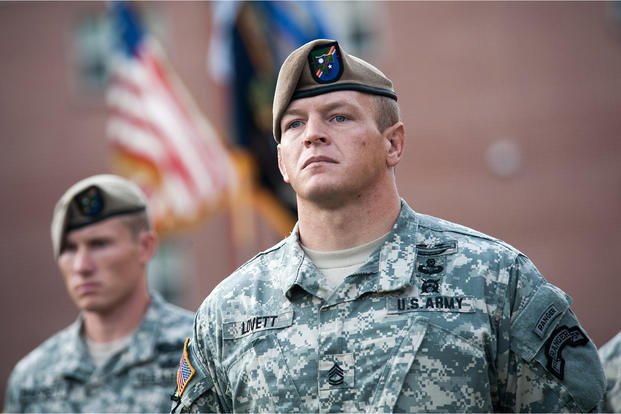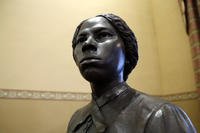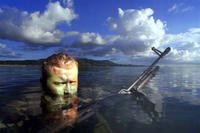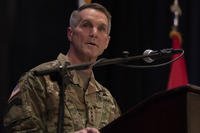Mission
"Rangers Lead the Way" isn't just a motto; it's a fact. Each Ranger battalion is capable of deploying anywhere in the world with only 18 hours notice. Rangers are part of a highly trained and rapidly deployable light infantry force with specialized skills that enable it to engage a variety of conventional and Special Operations targets.
The Rangers' primary mission is to engage the enemy in close combat and direct-fire battles. This mission includes direct-action operations, raids, personnel and special equipment recovery in addition to conventional or special light-infantry operations.
Becoming a Ranger requires completing one of the toughest military training schools in the world. Ranger candidates train to exhaustion, pushing the limits of their minds and bodies.
The motto "Rangers Lead the Way" has proven true for more than 60 years. Since the first group of handpicked volunteers was activated in World War II, Rangers have led the way on more than 50 military campaigns, including operations in Afghanistan and Iraq.
Known as the 75th Ranger Regiment, today's Rangers are the premier light infantry of the U.S. Army and serve as part of the U.S. Special Operations Command. Their mission is to plan and conduct special missions in support of U.S. policy and objectives.
Army Ranger History
U.S. Army Ranger history predates the Revolutionary War. In the mid-1700s, Capt. Benjamin Church and Maj. Robert Rogers formed Ranger units to fight during King Philip's War and the French and Indian War. Rogers wrote the 19 standing orders that are still in use today.
The Continental Congress formed eight companies of expert riflemen in 1775 to fight in the Revolutionary War. In 1777, this force of hardy frontiersmen commanded by Dan Morgan was known as The Corps of Rangers. Francis Marion, "The Swamp Fox," organized another famous Revolutionary War Ranger element known as Marion's Partisans.
During the War of 1812, companies of U.S. Rangers were raised from among the frontier settlers as part of the regular army. Throughout the war, they patrolled the frontier from Ohio to western Illinois on horseback and by boat. They participated in many skirmishes and battles with the British and their Indian allies. Many famous men belonged to Ranger units during the 18th and 19th centuries to include Daniel Boone and Abraham Lincoln.
The Civil War included Rangers such as John Singleton Mosby -- the most famous Confederate Ranger during the Civil War. His raids on Union camps and bases were so effective, part of north-central Virginia soon became known as Mosby's Confederacy.
After the Civil War, more than a half-century passed without military Ranger units in America. However, during World War II (1941-1945), the United States, using British Commando standards, activated six Ranger infantry battalions.
Maj. (later Brig. Gen.) William O. Darby organized and activated the 1st Ranger Battalion on June 19, 1942, at Carrickfergus, Northern Ireland. The 1st Ranger Battalion participated in the North African landing at Arzew, Algeria, the Tunisian Battles and the critical Battle of El Guettar.
The 3rd and 4th Ranger Battalions were activated and trained by Col. Darby in Africa near the end of the Tunisian Campaign. The 1st, 3rd, and 4th Battalions formed the Ranger Force. They began the tradition of wearing the scroll shoulder sleeve insignia, which has been adopted officially for today's Ranger battalions.
The 2nd and 5th Ranger Battalions participated in the June 6, 1944, D-Day landings at Omaha Beach, Normandy. It was during the bitter fighting along the beaches that the Rangers gained their motto, "Rangers, lead the way!" They conducted daring missions to include scaling the cliffs of Pointe Du Hoc, overlooking Omaha Beach, to destroy German gun emplacements trained on the beachhead.
The 6th Ranger Battalion operated in the Philippines and formed the rescue force that liberated American Prisoners Of War from a Japanese POW camp at Cabanatuan in January 1945. The 6th Battalion destroyed the Japanese POW camp and evacuated more than 500 prisoners.
The 75th Infantry Regiment was first organized in the China-Burma-India Theater on Oct. 3, 1943, as Task Force Galahad. It was during the campaigns in the China-Burma-India Theater that the regiment became known as Merrill's Marauders after its commander, Maj. Gen. Frank D. Merrill. The Ranger Battalions were deactivated at the close of WWII.
The outbreak of hostilities in Korea in June 1950 again signaled the need for Rangers. Fifteen Ranger Companies were formed during the Korean War. The Rangers went to battle throughout the winter of 1950 and the spring of 1951. They were nomadic warriors, attached first to one regiment and then to another. They performed "out-front" work -- scouting, patrolling, raids, ambushes, spearheading assaults and as counterattack forces to regain lost positions.
Rangers again were called to serve their country during the Vietnam War. The 75th Infantry was reorganized once more on Jan. 1, 1969, as a parent regiment under the Combat Arms Regimental System (CARS). Fifteen separate Ranger companies were formed from this reorganization. Thirteen served proudly in Vietnam until inactivation on Aug. 15, 1972.
In January 1974, Army Chief of Staff Gen. Creighton Abrams directed the formation of a Ranger battalion. The 1st Battalion (Ranger), 75th Infantry was activated and parachuted into Fort Stewart, Georgia, on July 1, 1974. The 2nd Battalion (Ranger), 75th Infantry followed with activation on Oct. 1, 1974. The 3rd Battalion, 75th Infantry (Ranger), and Headquarters and Headquarters Company, 75th Infantry (Ranger) received their colors on Oct. 3, 1984, at Fort Benning, Georgia. The 75th Ranger Regiment was designated in February 1986.
The modern Ranger battalions were first called upon in 1980. Elements of 1st Battalion, 75th Infantry (Ranger) participated in the Iranian hostage rescue attempts.
In October 1983, 1st and 2nd Ranger Battalions spearheaded Operation Urgent Fury by conducting a daring low-level parachute assault to seize Point Salines Airfield (now Maurice Bishop International Airport) in St. George's, Grenada, and rescue American citizens at True Blue Medical Campus.
The entire 75th Ranger Regiment participated in Operation Just Cause. Rangers spearheaded the action by conducting two important operations. Simultaneous parachute assaults were conducted onto Torrijos/Tocumen International Airport, Rio Hato Airfield and Gen. Manuel Noriega's beach house to neutralize Panamanian Defense Forces. The Rangers captured 1,014 enemy POWs and more than 18,000 arms of various types.
Elements of Company B and 1st Platoon Company A, 1st Battalion, 75th Ranger Regiment deployed to Saudi Arabia from Feb. 12, 1991, to April 15, 1991, in support of Operation Desert Storm.
In August 1993, elements of 3rd Battalion, and 75th Ranger Regiment, deployed to Somalia to assist United Nations forces in bringing order to a desperately chaotic and starving nation. On Oct. 3, 1993, the Rangers conducted a daring daylight raid with 1st SFOD-D. For nearly 18 hours, the Rangers delivered devastating firepower, killing an estimated 600 Somalis in what many have called the fiercest ground combat since Vietnam.
On Nov. 24, 2000, the 75th Ranger Regiment deployed Regimental Reconnaissance Detachment (RRD) Team 2 and a command and control element to Kosovo in support of TF Falcon.
After Sept. 11, 2001, Rangers were called upon to lead the way in the Global War on Terrorism. On Oct. 19, 2001, 3rd Battalion and 75th Ranger Regiment spearheaded ground forces by conducting an airborne assault to seize Objective Rhino in Afghanistan in support of Operation Enduring Freedom. On March 28, 2003, 3rd Battalion employed the first airborne assault in Iraq to seize Objective Serpent in support of Operation Iraqi Freedom.
Due to the changing nature of warfare and the need for an agile and sustainable Ranger Force, The Regimental Special Troops Battalion (RSTB) was activated on July 17, 2006. The RSTB conducts sustainment, intelligence, reconnaissance and maintenance missions that previously were accomplished by small detachments assigned to the regimental headquarters and then attached within each of the three Ranger battalions. The activation of the RSTB signifies a major waypoint in the transformation of the Ranger Force from a unit designed for short-term "contingency missions" to continuous combat operations without loss in lethality or flexibility.
Rangers from all four of its current battalions led the way in the Global War on Terrorism. The 75th Ranger Regiment conducted sustained combat operations in multiple countries deploying from multiple locations in the United States, a task that was unprecedented for the regiment. Rangers conducted combat operations with almost every deployed special operations, conventional and coalition force in support of Operation Enduring Freedom and Operation Iraqi Freedom. The Ranger Regiment executed a wide range of diverse operations, which included airborne and air assaults into Afghanistan and Iraq, and mounted infiltrations behind enemy lines, complex urban raids and rescue operations.
In addition to conducting missions in support of the Global War on Terrorism, the 75th Ranger Regiment trained in the United States and overseas to prepare for future no-notice worldwide combat deployments. The regiment continues to recruit, assess and train the next generation of Rangers and Ranger leadership.
Want to Know More About the Military?
Be sure to get the latest news about the U.S. military, as well as critical info about how to join and all the benefits of service. Subscribe to Military.com and receive customized updates delivered straight to your inbox.











